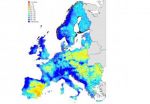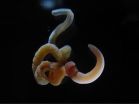(Press-News.org) A new assessment of available water resources, published today by the Joint Research Centre (JRC), reveals that large areas in Spain and Eastern Europe have on average less than 200 mm freshwater available every year while the demand for water is three to ten times higher. The report 'Current Water Resources in Europe and Africa' shows variations in yearly freshwater generation from 10 mm to over 500 mm for Europe and from less than 0.1 mm to over 500 mm for Africa. The report outlines existing uncertainties and points to further research efforts needed for improved water management. Its publication coincides with the 6th World Water Forum taking place in Marseille, France, from 12 to 17 March 2012.
Ensuring that water is available in sufficient quantities for all legitimate uses is a major policy challenge. The JRC carries out research to assess current and future water availability versus current and future water demands from different economic sectors. It analyses available water resources, floods, droughts and water scarcity using hydrological simulation modelling. Improved water management and forecasts of water scarcity are however complex issues and this JRC analysis of the water resources for Africa and Europe provides a solid foundation on which to address future challenges.
In Europe, most data needed for water resources assessment are already available but access to them still needs to be improved to achieve a pan-European overview. In particular the public availability of river flow observations needs to be addressed.
For the African continent the latest assessment of water resources reveals large areas with less than 200 mm freshwater generation per year. Higher values are measured only in parts of Equatorial Africa, Southwest Ethiopia, Eastern South-Africa and Madagascar. Water scarcity is particularly difficult to estimate since the most recent pan-African data on water use date back to the year 2000. In addition, and just as for Europe, information on inter river basin water transfers is often unavailable.
The lack of available observed river flow data for Africa, for example, creates a major bottleneck in calibrating and verifying hydrological models for this continent. The availability of meteorological observations acquired by satellite has, however, greatly improved for Africa.
INFORMATION:
Background:
The Joint Research Centre (JRC) is the European Commission's in-house science service. Its mission is to provide customer-driven scientific and technical support for the conception, development, implementation and monitoring of European Union policies. The JRC serves the common interest of the Member States, while being independent of special interests, whether private or national.
JRC's research activities on water resources include the development and use of an integrated modelling framework, linking land-use, hydrological and resource efficiency models. This allows proper quantitative assessment of various scenarios and the relevant policy options, taking into account cost-effectiveness of potential measures. This research supports several EU policies on water e.g. the "Blueprint to Safeguard Europe's Waters"
For further information:
The report 'Current Water Resources in Europe and Africa' can be downloaded at: http://publications.jrc.ec.europa.eu/repository/handle/111111111/23129
Contacts
JRC Press Office
Berta Duane, berta.duane@ec.europa.eu
Current water resources in Europe and Africa
Matching water supply and water demand
2012-03-15
ELSE PRESS RELEASES FROM THIS DATE:
Voters prefer candidates with deep voices
2012-03-15
CORAL GABLES, FL (March 14, 2012)--Convincing speeches are central to campaigning for elected office, but do our voices affect how we select our leaders? A newly-published paper in Proceedings of the Royal Society B: Biological Sciences shows that men and women vote for male and female candidates with lower-pitched voices. Men and women with lower voices were also found to be perceived as more competent, stronger, and more trustworthy. Each of these attributes is known to influence voters.
"Our study asks how voice pitch influences electability, and to my knowledge is ...
JAMA study finds patients with stroke symptoms are still not calling 911
2012-03-15
NEW YORK (March 14, 2012) -- Nationwide ambulance use by patients suffering from a stroke has not changed since the mid-1990s, even though effective stroke treatments are now available. In a study published in this week's Journal of the American Medical Association (JAMA), researchers at NewYork-Presbyterian Hospital/Weill Cornell Medical Center found that the number of stroke victims transported via ambulance has remained relatively static over the years, highlighting the need for more education about stroke symptoms and the importance of early intervention.
The study, ...
An evolutionary surprise
2012-03-15
WOODS HOLE, MA—The origin of the exquisitely complex vertebrate brain is somewhat mysterious. "In terms of evolution, it basically pops up out of nowhere. You don't see anything anatomically like it in other animals," says Ariel Pani, an investigator at the Marine Biological Laboratory (MBL) in Woods Hole and a graduate student at the University of Chicago.
But this week in the journal Nature, Pani and colleagues report finding some of the genetic processes that regulate vertebrate brain development in (of all places) the acorn worm, a brainless, burrowing marine invertebrate ...
How cancer cells start new tumor sites
2012-03-15
MAYWOOD, Il. -- A Loyola University Chicago Stritch School of Medicine study has revealed details of the complex molecular process involving a protein that enables cancer cells to establish tumors in distant parts of the body.
The finding could lead the way to new drugs to prevent breast cancer and other cancers from spreading to new sites.
The study by Adriano Marchese, PhD and colleagues is published in the March 16 issue of the Journal of Biological Chemistry, and is now available online.
The study involves a molecule on the surface of cells called CXCR4. There is ...
New labor-tracking tool proposed to reduce C-sections in first-time moms
2012-03-15
COLUMBUS, Ohio – Researchers have designed a new version of a labor-tracking tool for pregnant women that they predict could reduce the use of hormonal intervention during labor and lower the number of cesarean sections performed on low-risk, first-time mothers.
The tool, called a partograph, takes into account the most recent research findings that suggest labor is not a linear process, but is instead slower during earlier labor and accelerates gradually as labor advances. A diagnosis of abnormally slow labor is the No. 1 reason that C-sections are performed in low-risk ...
I&K International Announces Rise in Sales of Male Grooming Products
2012-03-15
I&K International has announced a significant increase in sales of products from its men's range. The surge in sales is believed to have been a direct result of the addition of new men's products over the last few years, as well as a general increase in the amount of attention men are paying to grooming.
Indeed, the company has saw a 60% rise in the number of men buying these products when compared to the same time last year. These figures would seem to indicate that men are paying more attention to their physical appearance and grooming than ever before, and Kevin ...
Size isn't everything -- it's how sharp you are
2012-03-15
For 300 million years, Earth's oceans teemed with conodonts – early vertebrates that kept their skeleton in their mouth. The elements of this skeleton look uncannily like teeth (see image) and, like teeth, they were often worn and broken during life. This evidence strongly suggests that conodonts evolved the first vertebrate dentitions.
Scientists know that conodont elements worked differently from the teeth of other animals: they are microscopic – about 2 to 0.2 mm long – and must have had paltry muscles to move them, with no jaws to which they could attach. So how ...
UCI-led study uncovers how Salmonella avoids the body's immune response
2012-03-15
Irvine, Calif., March 14, 2012 — UC Irvine researchers have discovered how Salmonella, a bacterium found in contaminated raw foods that causes major gastrointestinal distress in humans, thrives in the digestive tract despite the immune system's best efforts to destroy it.
Their findings help explain why Salmonella is difficult to eradicate and point to new approaches for possible treatments. Most people infected with Salmonella suffer from diarrhea, fever and abdominal cramps for up to seven days before the infection resolves.
Lead researcher Manuela Raffatellu, a UCI ...
The Brazilian Navy faces its worst enemy in WWI: The Spanish flu
2012-03-15
Few people know about the participation of Brazil in Word War I. Although Brazil remained neutral during most of the conflict, it eventually sent a fleet to support the war effort against the central powers. It was the only Latin-American country to do so. But the Brazilian expedition encountered an unexpected and treacherous enemy in the African coast against which -like all other Armies- it was not prepared for: the Spanish flu.
The Spanish flu swept the globe in 1918-1919 and in a few months made more victims than the total number of battlefield deaths during the ...
Study suggests link between H. pylori bacteria and blood sugar control in adult Type 2 diabetes
2012-03-15
NEW YORK, March 14, 2012 – A new study by researchers at NYU Langone Medical Center reveals that the presence of Helicobacter pylori (H. pylori) bacteria is associated with elevated levels of glycosylated hemoglobin (HbA1c), an important biomarker for blood glucose levels and diabetes. The association was even stronger in obese individuals with a higher Body Mass Index (BMI). The results, which suggest the bacteria may play a role in the development of diabetes in adults, are available online in The Journal of Infectious Diseases.
There have been several studies evaluating ...
LAST 30 PRESS RELEASES:
Understanding sex-based differences and the role of bone morphogenetic protein signaling in Alzheimer’s disease
Breakthrough in thin-film electrolytes pushes solid oxide fuel cells forward
Clues from the past reveal the West Antarctic Ice Sheet’s vulnerability to warming
Collaborative study uncovers unknown causes of blindness
Inflammatory immune cells predict survival, relapse in multiple myeloma
New test shows which antibiotics actually work
Most Alzheimer’s cases linked to variants in a single gene
Finding the genome's blind spot
The secret room a giant virus creates inside its host amoeba
World’s vast plant knowledge not being fully exploited to tackle biodiversity and climate challenges, warn researchers
New study explains the link between long-term diabetes and vascular damage
Ocean temperatures reached another record high in 2025
Dynamically reconfigurable topological routing in nonlinear photonic systems
Crystallographic engineering enables fast low‑temperature ion transport of TiNb2O7 for cold‑region lithium‑ion batteries
Ultrafast sulfur redox dynamics enabled by a PPy@N‑TiO2 Z‑scheme heterojunction photoelectrode for photo‑assisted lithium–sulfur batteries
Optimized biochar use could cut China’s cropland nitrous oxide emissions by up to half
Neural progesterone receptors link ovulation and sexual receptivity in medaka
A new Japanese study investigates how tariff policies influence long-run economic growth
Mental trauma succeeds 1 in 7 dog related injuries, claims data suggest
Breastfeeding may lower mums’ later life depression/anxiety risks for up to 10 years after pregnancy
Study finds more than a quarter of adults worldwide could benefit from GLP-1 medications for weight loss
Hobbies don’t just improve personal lives, they can boost workplace creativity too
Study shows federal safety metric inappropriately penalizes hospitals for lifesaving stroke procedures
Improving sleep isn’t enough: researchers highlight daytime function as key to assessing insomnia treatments
Rice Brain Institute awards first seed grants to jump-start collaborative brain health research
Personalizing cancer treatments significantly improve outcome success
UW researchers analyzed which anthologized writers and books get checked out the most from Seattle Public Library
Study finds food waste compost less effective than potting mix alone
UCLA receives $7.3 million for wide-ranging cannabis research
Why this little-known birth control option deserves more attention
[Press-News.org] Current water resources in Europe and AfricaMatching water supply and water demand

